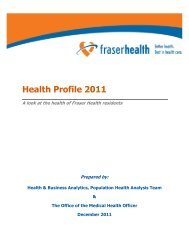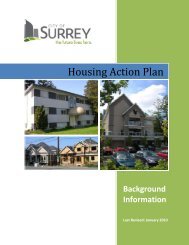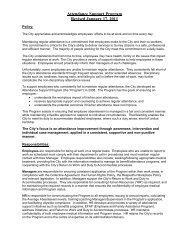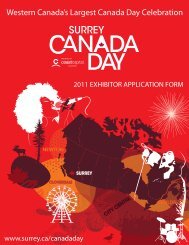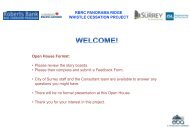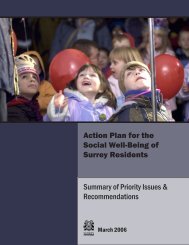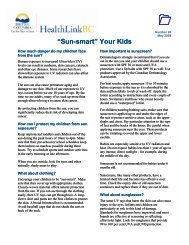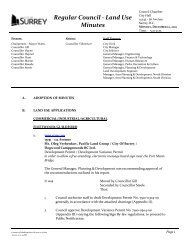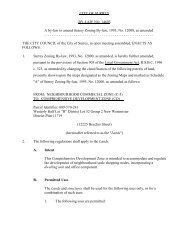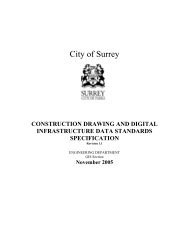Blackie Spit Park: Wildlife Habitat Enhancement Plan - City of Surrey
Blackie Spit Park: Wildlife Habitat Enhancement Plan - City of Surrey
Blackie Spit Park: Wildlife Habitat Enhancement Plan - City of Surrey
You also want an ePaper? Increase the reach of your titles
YUMPU automatically turns print PDFs into web optimized ePapers that Google loves.
2.0 Goals and Objectives<br />
Species Management Goal<br />
Grassland-dwelling species <strong>of</strong> small mammals and their predators (e.g., herons, raptors, coyotes), and<br />
grassland passerines (breeding savannah sparrows and other wintering sparrows).<br />
<strong>Habitat</strong> Management Objectives<br />
• Renovate fields, as necessary, to maintain the grass species mix and old-field structure necessary<br />
for the target and other associated wildlife species. The planted pines could be left as perches.<br />
• Mow fields as required (at the most annually), to maintain the desired grass height and to control<br />
undesired shrubs and blackberries (this applies especially to the north portion).<br />
• Remove invasive species (e.g. reed canarygrass, blackberries, escaped garden plants).<br />
• Maintain a hedgerow along the west side and south <strong>of</strong> MU 3.<br />
• Public viewing will continue to be from adjacent roads and dykes, with no access to the interior.<br />
3.0 Management Prescriptions<br />
Most <strong>of</strong> Dunsmuir Farm will be maintained as an old-field. The habitat characteristics <strong>of</strong> the southern<br />
part are currently suitable and no management is recommended in the short term. The reed<br />
canarygrass <strong>of</strong> the northern field is usually indicative <strong>of</strong> wet conditions, and is tall, making predator<br />
access to prey impossible, and is expected to support a lower abundance <strong>of</strong> voles and other small<br />
mammals than the more plant species-rich old-field to the south. Much <strong>of</strong> the canarygrass area needs<br />
to be renovated. The extensive areas <strong>of</strong> blackberry in the north also need to be renovated.<br />
3.1 Initial <strong>Enhancement</strong> Requirements<br />
• Renovate the parts <strong>of</strong> the field that are in canarygrass and plant with a DF&WT 1 set-aside seed<br />
mix. Renovation will entail cutting the grass and tilling the soil before planting the new seed.<br />
Tilling will entail ploughing and discing, or rototilling. Eliminating the reed canarygrass may<br />
require special procedures and a multi-year effort; consult the Ministry <strong>of</strong> Agriculture in<br />
Cloverdale or Abbotsford.<br />
• While renovating the north area, ensure that the land is graded, sloped and ditched so that it will<br />
drain freely during heavy rains.<br />
• Cut and till the east end to eliminate invasive species, and when the regeneration <strong>of</strong> undesirable<br />
species is under control, plant with DF&WT set-aside mix.<br />
1<br />
The Delta Farmland and <strong>Wildlife</strong> Trust uses a seed mix designed to benefit both wildlife and soil<br />
development. For the currently used mix, call Dawsons’ Seeds (Bill Awmack) or the DF&WT.<br />
<strong>Blackie</strong> <strong>Spit</strong> <strong>Park</strong>: <strong>Wildlife</strong> <strong>Habitat</strong> <strong>Enhancement</strong> <strong>Plan</strong> – Management Unit 4 34



